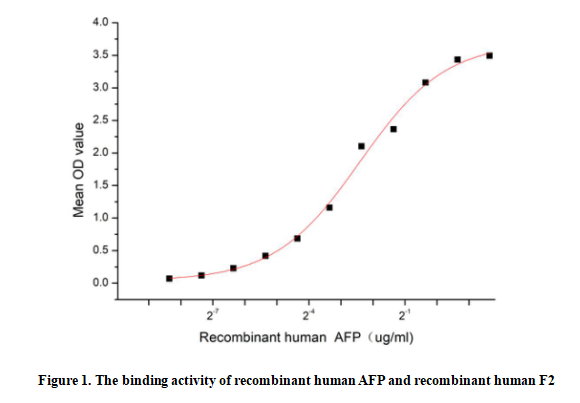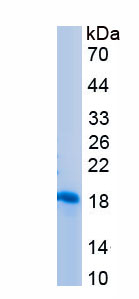Active Alpha-Fetoprotein (AFP)
aFP; A-FP; FETA; HPAFP; Alpha-Fetoglobulin; Alpha-1-fetoprotein
- Product No.APA153Hu01
- Organism SpeciesHomo sapiens (Human) Same name, Different species.
- Buffer FormulationPBS, pH7.4, containing 0.01% SKL, 5% Trehalose.
- Traits Freeze-dried powder
- Purity> 90%
- Isoelectric Point5.2
- ApplicationsCell culture; Activity Assays.
- DownloadInstruction Manual
- UOM 10µg50µg 200µg 1mg 5mg
- FOB
US$
US$
US$
US$
US$
For more details, please contact local distributors!
ACTIVITY TEST

Alpha-Fetoprotein (AFP), as known as fetal alpha globulin or alpha-1-fetoprotein, is a glycoprotein belonging to the albumin family that is produced mainly by the fetal liver and yolk sac during pregnancy. Its primary function in the fetus is to transport calcium and fatty acids across the placenta, supporting fetal growth and development. In adults, elevated AFP levels can indicate certain medical conditions, including liver cancer and other diseases. Besides, Coagulation Factor II (F2) has been identified as an interactor of AFP, thus a functional binding ELISA assay was conducted to detect the interaction of recombinant human AFP and recombinant human F2. Briefly, AFP was diluted serially in PBS with 0.01% BSA (pH 7.4). Duplicate samples of 100 μl were then transferred to F2-coated microtiter wells and incubated for 1h at 37℃. Wells were washed with PBST and incubated for 1h with anti-AFP pAb, then aspirated and washed 3 times. After incubation with HRP labelled secondary antibody for 1h at 37℃, wells were aspirated and washed 5 times. With the addition of substrate solution, wells were incubated 15-25 minutes at 37℃. Finally, add 50 µL stop solution to the wells and read at 450/630 nm immediately. The binding activity of recombinant human AFP and recombinant human F2 was shown in Figure 1, the EC50 for this effect is 1.06 ug/mL.
USAGE
Reconstitute in 10mM PBS (pH7.4) to a concentration of 0.1-1.0 mg/mL. Do not vortex.
STORAGE
Avoid repeated freeze/thaw cycles. Store at 2-8°C for one month. Aliquot and store at -80°C for 12 months.
STABILITY
The thermal stability is described by the loss rate. The loss rate was determined by accelerated thermal degradation test, that is, incubate the protein at 37°C for 48h, and no obvious degradation and precipitation were observed. The loss rate is less than 5% within the expiration date under appropriate storage condition.
GIVEAWAYS
INCREMENT SERVICES
-
 BCA Protein Quantification Kit
BCA Protein Quantification Kit
-
 Molecular Mass Marker for Protein
Molecular Mass Marker for Protein
-
 Monoclonal Antibody Customized Service
Monoclonal Antibody Customized Service
-
 Polyclonal Antibody Customized Service
Polyclonal Antibody Customized Service
-
 Protein Activity Test Experiment Service
Protein Activity Test Experiment Service
-
 Electrophoretic Mobility Shift Assay (EMSA) Experiment Service
Electrophoretic Mobility Shift Assay (EMSA) Experiment Service
-
 Buffer
Buffer
-
 Lentivirus Packaging Experiment Service
Lentivirus Packaging Experiment Service
-
 Adenovirus Packaging Experiment Service
Adenovirus Packaging Experiment Service
-
 Real Time PCR Experimental Service
Real Time PCR Experimental Service
-
 Spike RBD Protein (S-RBD)
Spike RBD Protein (S-RBD)
-
 Protein G
Protein G
-
 Protein A
Protein A
| Magazine | Citations |
| BioFactors | Ginger ingredients inhibit the development of diethylnitrosoamine induced premalignant phenotype in rat chemical hepatocarcinogenesis model PubMed: 20872761 |
| Food and Nutrition Sciences | Investigation of the Biochemical and Histological Changes Induced by Zearalenone Mycotoxin on Liver in Male Mice and the Protective Role of Crude Venom Extracted from Jellyfish Cassiopea Andromeda. Scirp: 5684 |
| Diabetes Research and Clinical Practice | Polyol profile as an early diagnostic and prognostic marker in natural product chemoprevention of hepatocellular carcinoma in diabetic rats ScienceDirect: S0168822711000520 |
| Life Sciences | Comparison of angiotensin converting enzyme inhibitors and angiotensin II type 1 receptor blockade for the prevention of premalignant changes in the liver ScienceDirect: S0024320511002700 |
| Annals of Hepatology | Cytokines as important playmakers of experimental hepatocarcinogenesis confounded by diabetes. Hepatology: source |
| Biomedicine & Aging Pathology | Chemopreventive and therapeutic efficacy of Salsola inermis extract against N-nitrosodiethylamine-initiated and phenobarbital-promoted hepatocellular carcinogenesis in Wistar rats ScienceDirect: S2210522013000348 |
| European journal of pharmacology | Suramin inhibits hepatic tissue damage in hepatocellular carcinoma through deactivation of heparanase enzyme Pubmed: 24530413 |
| Asian Pac J Cancer Prev. | Association of Paraoxonase-1 (Q192R and L55M) Gene Polymorphisms and Activity with Colorectal Cancer and Effect of Surgical Intervention. Pubmed:25684529 |
| Journal of Analytical Atomic Spectrometry | Detection of HIV-1 p24 antigen using streptavidin–biotin and gold nanoparticles based immunoassay by inductively coupled plasma mass spectrometry Rsc:Source |
| PLOS ONE | Development of a Highly Sensitive Glycan Microarray for Quantifying AFP-L3 for Early Prediction of Hepatitis B Virus–Related Hepatocellular Carcinoma Pubmed:24927126 |
| BMC Med Imaging | Evaluation of 11C-acetate and 18F-FDG PET/CT in mouse multidrug resistance gene-2 deficient mouse model of hepatocellular carcinoma PubMed: 25981587 |
| Tumour Biol | Elevated serum soluble CD14 levels in chronic HBV infection are significantly associated with HBV-related hepatocellular carcinoma PubMed: 26643893 |
| Acta Veterinaria Brno | The concentrations of selected blood serum proteins in calves during the first three months of life 85:33 |
| Hepatobiliary Pancreat Dis Int | Predictive value of tumor markers in patients with recurrent hepatocellular carcinoma in different vascular invasion pattern abstract:abstract4525.shtml |
| Journal of Applied Pharmaceutical Science | Chemopreventive effect of Indigofera linnaei extract against diethylnitrosamine induced hepatocarcinogenesis in rats 2071_pdf.pdf |
| Frontiers in Physiology | Anticarcinogenic potential of ethanol extract of Indigofera cordifolia Roth.(Fabales: Fabaceae) on diethylnitrosamine induced hepatocarcinogenesis in rats v04n07a07a |
| International Journal of Clinical and Experimental Medicine | Effect of Mesenchymal Stem Cells on Transforming Growth Factor Beta Level in Hepatocellular Carcinoma Induced Rat Model 1345-1349 |
| Tumor Biology | Antiangiogenic activity of vitexicarpine in experimentally induced hepatocellular carcinoma: Impact on vascular endothelial growth factor pathway pubmed:28651490 |
| Advances in Clinical and Experimental Medicine | Mesenchymal stem cell therapy of hepatocellular carcinoma in rats: Detection of cell homing and tumor mass by magnetic resonance imaging using iron oxide nanoparticles ISSN 2451-2680 |
| Tumor biology | Evaluation of the antitumor activity of platinum nanoparticles in the treatment of hepatocellular carcinoma induced in rats pubmed:28720064 |
| EBioMedicine | Lnc-PCDH9-13: 1 Is a Hypersensitive and Specific Biomarker for Early Hepatocellular Carcinoma Pubmed:30045829 |
| Sensors and Actuators B: Chemical | One-pot synthesis of a highly selective carboxyl-functionalized superparamagnetic probes for detection of alpha-fetoprotein 10.1016:j.snb.2018.03.038 |
| Biomedicine & Pharmacotherapy | Cytotoxic and partial hepatoprotective activity of sodium ascorbate against hepatocellular carcinoma through inhibition of sulfatase-2 and Pubmed:29669302 |
| Journal of Investigative Surgery | Dynamic Volume Assessment of Hepatocellular Carcinoma in Rat Livers Using a Clinical 3T MRI and Novel Segmentation Pubmed:28107094 |
| Asian Pacific Journal of Cancer Prevention | Impact of Mesenchymal Stem Cells and Vitamin D on Transforming Growth Factor Beta Signaling Pathway in Hepatocellular Carcinoma in Rats Pubmed:29693337 |
| Antioxid Redox Signal | The Association of Peroxiredoxin 4 with the Initiation and Progression of Hepatocellular Carcinoma Pubmed:29687726 |
| Cancer Biology | Chemoprotective Efficacy of Curcumin and Flax Seed Oil in 1, 2-Dimethylhydrazine Induced Rat Colon Cancer |
| Cancer Biology | Ameliorative effects of honey and venom of honey bee on induced colon cancer in male albino rats by1, 2 dimethylhydrazine |
| Biomedicine & Pharmacotherapy | The therapeutic effects of nicotinamide in hepatocellular carcinoma through blocking IGF-1 and effecting the balance between Nrf2 and PKB Pubmed: 30784932 |
| Asian Journal of Pharmacy and Pharmacology | Chemopreventive effects of on diethylnitrosamine induced and Indigofera cassioides phenobarbital promoted rat liver carcinoma |
| American Journal of Transplantation | Circulating exosomal miR‐92b: Its role for cancer immunoediting and clinical value for prediction of posttransplant hepatocellular carcinoma recurrence Pubmed: 31162867 |
| Environ Toxicol Pharmacol. | Targetingp53/TRAIL/caspase-8 signaling by adiponectin reverses thioacetamide-induced hepatocellular carcinoma in rats Pubmed: 31421311 |
| Hepatology Research | Glutamine synthetase promotes tumor invasion in hepatocellular carcinoma through mediating epithelial–mesenchymal transition Pubmed: 31652385 |
| REDOX REPORT | Selective cytotoxic activity and protective effects of sodium ascorbate against hepatocellular carcinoma through its effect on oxidative stress and apoptosis in vivo and … Pubmed: 32172678 |
| Scientific Reports | The possible role of Dickkopf-1, Golgi protein-73 and Midkine as predictors of hepatocarcinogenesis: a review and an Egyptian study Pubmed: 32198440 |
| Nutr Cancer | Fucoidan Ameliorates Hepatocellular Carcinoma Induced in Rats: Effect on miR143 and Inflammation Pubmed: 32718197 |
| Lateral Flow Immunosensor for Ferritin Based on Dual Signal-Amplified Strategy by Rhodium Nanoparticles | |
| Microchemical Journal | Magnetic immunoassay for tumor clinical diagnosis based on rolling circular amplification (RCA) coupled with ICP-MS |
| Identification of Polyphenolic Compounds and Hepatoprotective Activity of Artichoke (Cynara Scolymus L.) Edible Part Extracts in Rats | |
| Anticancer efficacy of β-Sitosterol Loaded Hydroxyapatite-Alginate on Colon Cancer Cell in Vivo | |
| DEVELOPMENT | Blocking estrogen-induced AMH expression is crucial for normal follicle formation 33658225 |
| Cytokine | QNZ alleviated hepatocellular carcinoma by targeting inflammatory pathways in a rat model 34564023 |
| Journal of Gastrointestinal Cancer | In Vivo Study of a Newly Synthesized Chromen-4-One Derivative as an Antitumor Agent Against HCC 34698995 |







